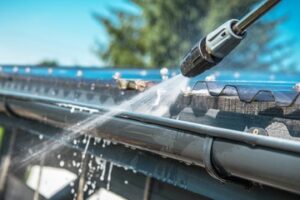Sarasota Roof Cleaning is the process of removing stains and growths such as algae, mold, mildew, moss and lichen from shingle roofing materials. It can also be used to remove oxidation from metal roofing materials.

One of the main benefits of roof cleaning is that it can increase the curb appeal of a home or building. It can also improve the overall energy efficiency of a property.
The roof is one of the most durable features of your home. It protects you from the elements, but it does require regular maintenance to keep it in good condition. A dirty roof can cause damage to your home, leading to costly repairs and replacements. It can also reduce the value of your home. Regular roof cleaning can prevent these problems and increase your home’s value.
The cost of roof cleaning depends on several factors, including the size of your roof, the type of roof material and the treatment method. You can expect to pay between $0.20 and $0.60 per square foot for a full clean of your roof. This includes the removal of all growth, gutter cleaning, and a sterilization treatment. The cost may be slightly higher for concrete tile roofs, which can be more difficult to clean.
Other costs can include the purchase of specialized equipment and supplies, as well as labor charges. The amount you spend will also depend on how large or small your roof is and whether it has a steep slope or not. In addition to this, you will need to consider any additional services you might want to add on, such as the application of zinc oxide strips, which prevent moss and algae from growing.
You should hire a professional roof cleaner with experience and a good reputation in the industry. It is best to get quotes from a few different companies before making your decision. Check out each company’s website and social media pages to find out more about their history and customer reviews.
When choosing a contractor, be wary of those who charge extremely low prices. They are likely to leave bits of moss roots and spores alive, which means they will return twice as fast as those that have been fully killed. In addition, they may not thoroughly clean the surface of your roof and will probably skip other important areas, such as the eaves and valleys. A reputable contractor will provide a thorough clean at a fair price.
Safety
When a home needs cleaning, it’s easy to overlook the roof. But a clean roof can help protect the interior and extend the life of your home’s structure. It also can increase its value and prevent costly repairs.
However, before you begin your roof cleaning, make sure that you follow the necessary safety precautions. These include wearing appropriate clothing, using a ladder with stabilizers, and using safe cleaning products. The first step is to clear away any standing water and large debris from the area. In addition, it’s a good idea to trim any overhanging branches that might fall on the roof and cause damage or block water flow.
A clean roof can protect your family from mold and other health hazards, as well as extend the life of the structure. It can also prevent moisture damage, which can cause rotting, leaks, and other problems throughout the house. The removal of moss, mildew, and dirt can also reduce the amount of allergens in the home’s air.
If you’re going to tackle the job yourself, it’s important to know that different roof materials require different cleaning techniques. For example, tile roofs should be cleaned by hand rather than power-washed to avoid damaging the tiles. If you’re going to use a power-washer, be sure to set it to a low pressure setting and only spray a small section of the roof at a time.
Before you start the cleaning process, it’s a good idea to walk around the entire roof and look for problem areas. These can include loose shingles, areas that need extra cleaning, or any other issues that you’ll want to address. It’s also a good idea to take note of the weather conditions. If it’s rainy or windy, you may want to postpone the project until the conditions improve.
It’s also a good idea to wear rubber soled shoes, a long-sleeved shirt, and sunglasses or goggles for protection from the sun’s harmful UV rays. A hat might provide additional protection as well, if needed. If you’re going to use scrubbing equipment, it’s also a good idea to wear heavy-duty gloves to protect your hands from the chemicals in the cleaning solution.
Algae Removal
If left untreated, algae can eat through shingles and cause roof leaks and interior mold. It is important to have this growth removed as soon as it appears. A professional roofing company can remove algae, moss and lichen from your roof, restore it to like-new condition, and prevent future growth.
While many homeowners attempt to clean their own roofs, it is not recommended. Climbing on a roof can be dangerous, especially with slippery algae covering surfaces. This hazard increases the need for safety equipment like ladder stabilizers, a fall harness and non-slip shoes.
Algae can be a difficult problem to remove on your own, and even professional roof cleaners often cannot completely eliminate the dark streaks of this type of growth. The best way to keep a roof free of algae is to install strips of zinc or copper under the shingles. These metals contain a chemical that will kill any algae trying to reclaim a foothold on the roof.
In addition to killing the algae, a professional roof cleaning will also remove any mold or mildew that has formed underneath the shingles. This treatment will help the shingles last longer and can reduce the need for expensive roof repairs in the future.
The ARMA recommends using a bleach solution without the use of a pressure washer to remove moss and algae from roofs. This will ensure that the cleaning solution does not damage the shingles, and it will also protect the foundation plantings around your home. Before applying the bleach, it is a good idea to wet these plants with plain water to protect them from the harsh chemicals.
Once the roof is cleaned, it will need to be rinsed to remove any detergent residue that remains. This process is best done on a cloudy day to avoid overexposure to sunlight, which can accelerate the deterioration of shingles.
A professional roof cleaning will also use a rinsing system that is designed to penetrate all the nooks and crannies of the roof, breaking up and dissolving dirt and debris trapped under the shingles and in the eaves. This low-pressure rinsing system will not strip the shingles of their protective granules and will help them stay in place during the drying process.
Damage Repair
The roof is one of the most important structures in any home. It provides vital protection against heat, rain, wind, snow and other harmful elements that can damage the exterior of the house. Unfortunately, many homeowners fail to give the roof the care and attention it deserves. This can lead to a variety of issues that can be quite costly and even threaten the integrity of the entire structure. For example, if moss and algae are left unchecked they can eat through the tiles causing leakage which could eventually lead to structural damage. In addition, a dirty roof can attract insects and rodents and lead to mold and mildew growth which can cause health issues for the occupants of the home.
To help protect the investment in your roof, it is important to hire a professional to clean and repair it. Whether you are dealing with algae stains, moss, or other unsightly blemishes, these professionals can remove these stains and return your roof to its original appearance. Additionally, they can also inspect your roof for other damages, such as loose shingles or worn flashing.
During the cleaning process, professionals pay special attention to the chimney and attic insulation. In addition, they make sure that all the gutters are free of debris and that there are no signs of leaks. If they notice any, they can easily make repairs before the damage spreads.
When it comes to the cost of roof cleaning, the amount of damage that needs to be repaired can greatly influence the final price. Minor issues will be on the lower end of the spectrum, while extensive repairs will be more expensive. Depending on the type of materials needed for the repair, the price may also vary. In general, high-quality and specialized materials will carry a higher price tag than standard materials.
Before beginning the cleaning process, professionals will sweep the entire surface of the roof to remove any loose twigs, leaves, and other debris. They will then cover any plants or grass near the roof with tarps or plastic sheets to prevent them from being damaged by runoff or cleaning solutions. In addition, they will take precautions to ensure that the cleaning solution does not get into any cracks or crevices on the roof where it can cause damage.


